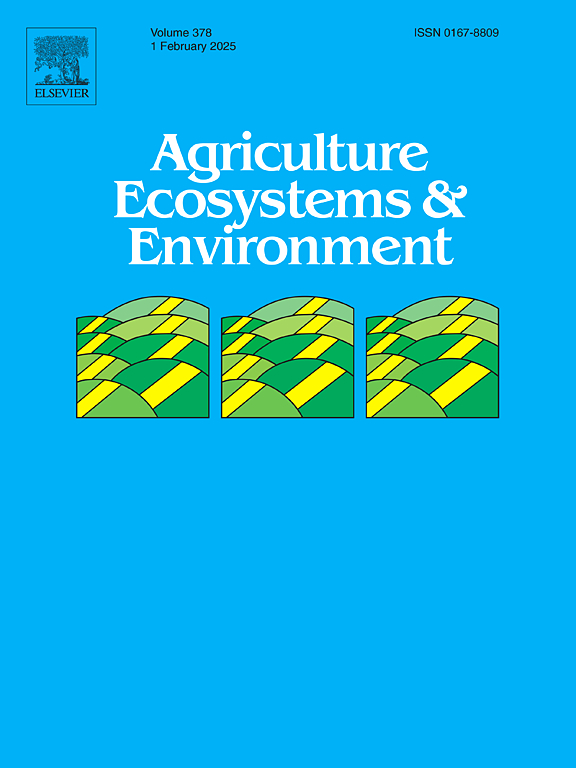Unveiling hidden threats: Nitrate pollution in agricultural catchments with deep vadose zone
IF 6
1区 农林科学
Q1 AGRICULTURE, MULTIDISCIPLINARY
引用次数: 0
Abstract
Identifying dominant nitrogen sources in groundwater and surface water is critical for controlling non-point source (NPS) pollution in agricultural watersheds. However, in regions with deep vadose zones (>4 m) and limited precipitation. However, in regions with deep vadose zones (>4 m) and limited precipitation, the hidden threats of agricultural NPS pollution remain critically understudied due to prolonged pollution retention and insufficient transport dynamics. Here, we investigated the transport routes of surplus N and the driving mechanism of NPS pollution in a semi-humid agricultural catchment with vadose zone thickness exceeding 80 m and large-scale apple orchards, through a combined approach of questionnaire survey, hydrochemistry, multi-isotope tracer technology (δ15N-NO3, δ18O-NO3, δ2H-H2O, δ18O-H2O) and MixSIAR model. The results indicated that the high nitrogen input and surplus in apple orchards led to an annual potential nitrogen loss in runoff up to 257.88 kg·ha−1, 3.7 times that of croplands. Heavy precipitation was the main driving force for the loss of residual soil nitrogen. As the main form of inorganic nitrogen in water, the nitrate concentration in surface water peaked at 8.63 mg L−1 during heavy rainfall, approaching the drinking water safety threshold of World Health Organization. Simultaneously, precipitation contribution to surface water increased sharply to 66.2 %. This resulted in a rapid rise in the proportion of nitrate derived from fertilizer and soil nitrogen, rising from 2 % to 90 %. Thus, the surface water nitrate mainly originated from agricultural surplus nitrate during heavy precipitation. In contrast, during periods without heavy precipitation, groundwater was the dominant source (>80 %) of surface water recharge, making groundwater the main source of surface water nitrate. Critically, the deep vadose zone has effectively impeded the leaching of agricultural surplus nitrate into groundwater so far. Therefore, groundwater nitrate and surface water nitrate without heavy precipitation both mainly (> 90 %) originated from manure and sewage. This study emphasized that heavy precipitation periods were the high-risk intervals for nitrogen NPS pollution in agricultural area with deep vadose zone and limited precipitation, providing scientific support for targeted NPS pollution prevention and control strategies.
揭露隐藏的威胁:深渗透区农业集水区硝酸盐污染
确定地下水和地表水的优势氮源是控制农业流域非点源污染的关键。然而,在深水汽带(>4 m)和降水有限的地区。然而,在深渗透带(>4 m)和降水有限的地区,由于污染滞留时间长,运输动力学不足,农业NPS污染的潜在威胁仍未得到充分研究。本文采用问卷调查、水化学、多同位素示踪技术(δ15N-NO3、δ18O-NO3、δ2H-H2O、δ18O-H2O)和MixSIAR模型相结合的方法,研究了渗流带厚度超过80 m的半湿润农业流域和大型苹果园中剩余氮的运输路径和NPS污染的驱动机制。结果表明,苹果果园高氮输入和高氮盈余导致年径流潜在氮损失高达257.88 kg·ha−1,是农田的3.7倍。强降水是土壤残氮流失的主要驱动力。作为水体中无机氮的主要形式,暴雨期间地表水硝酸盐浓度达到峰值8.63 mg L−1,接近世界卫生组织饮用水安全阈值。同时,降水对地表水的贡献急剧增加,达到66.2% %。这导致肥料和土壤氮中硝酸盐的比例迅速上升,从2% %上升到90% %。因此,地表水硝酸盐主要来源于强降水期间的农业剩余硝酸盐。而在非强降水时期,地下水是地表水补给的主要来源(>80 %),地下水是地表水硝酸盐的主要来源。至关重要的是,深层渗透带迄今为止有效地阻碍了农业剩余硝酸盐向地下水的浸出。因此,无强降水的地下水硝酸盐和地表水硝酸盐主要为(>;90 %)来源于粪肥和污水。本研究强调强降水期是深渗透带、降水有限的农业区氮素NPS污染的高危期,为有针对性的NPS污染防治策略提供科学支撑。
本文章由计算机程序翻译,如有差异,请以英文原文为准。
求助全文
约1分钟内获得全文
求助全文
来源期刊

Agriculture, Ecosystems & Environment
环境科学-环境科学
CiteScore
11.70
自引率
9.10%
发文量
392
审稿时长
26 days
期刊介绍:
Agriculture, Ecosystems and Environment publishes scientific articles dealing with the interface between agroecosystems and the natural environment, specifically how agriculture influences the environment and how changes in that environment impact agroecosystems. Preference is given to papers from experimental and observational research at the field, system or landscape level, from studies that enhance our understanding of processes using data-based biophysical modelling, and papers that bridge scientific disciplines and integrate knowledge. All papers should be placed in an international or wide comparative context.
 求助内容:
求助内容: 应助结果提醒方式:
应助结果提醒方式:


